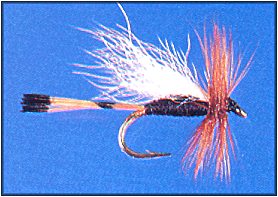|
The Trude
This pattern was originated in the summer of 1906 by Carter H. Harrison
of Chicago, Illinois, while he was a guest at the A.S. Trude Ranch near
Big Springs, Idaho.
The fly was created one evening on a whim using red yarn from a cabin rug for the
body and hair from a red spaniel for the wing. It had enough appeal that is was
later tied as I have described here except it had no tail. . .
Original Trude
- Hooks: TMC3761 or DAI1550, sizes 6-10.
- Thread: Black.
- Tail: Narrow red goose quill section.
- Ribbing: Flat silver tinsel.
- Body: Dubbed with #4 red lambs wool.
- Wing: Fox squirrel tail over the body.
- Hackle: Dark ginger tied on as a collar and tied back.
. . . It proved itself well on the Snake River where everyone caught
more fish than they could carry. The word then spread to other parts
of the Rocky Mountain West. Bill Beaty, one of Montana's commercial
tiers of the time, added the red goose quill tail. Cliff Wyatt of Santa Monica,
California later added his variations of the pattern. . . . Pat Barns of West
Yellowstone, Montana, took the two ideas and combined them, creating the
Sofa Pillow. This time the fly emerged as a dry fly. Dan Bailey of Livingston
Montana, not wanting to be left out of the action, came up with his variations
of the Trude. They had red, yellow and orange bodies with hackle tied
Adams style.
From Harrison's original hairwing style, fly tiers all over the country started
experimenting on both wet and dry flies.
By substituting the feather style wings with hair they often concluded that they
had a Trude fly, never stopping to think that what they had was a hairwing
variation. Such patterns as the Royal Coachman came to be known as the
Royal Trude when it fact it could only be defined as a "Hairwing
Royal Coachman." Substituting hair for feathers on all manner
of flies took place. In reviewing just the streamers, steelhead and atlantic
salmon flies alone one will quickly see where many of their original dressings
called from feather wings. There may have been whose who used the idea
of "hairwings" prior to Harrison but it is doubtful that any
were ever as successful as his original Trude.
At this point I want to go through the step of tying a Trude style [dry] fly.
Materials List for the Rio Grande King Trude:
(Rio Grande Bucktail)
- Hook: TMC9300 or DA11550, sizes 10-16.
- Thread: Black.
- Tip: Flat gold tinsel.
- Tail: Golden pheasant tippet barbs.
- Body: Dubbed with #1 black poly.
- Wing: White calf tail tied over the body.
- Hackle: Brown tied on as a collar in front of the wing.
|







